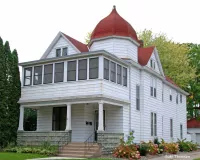Share what you know,
and discover more.
Share what you know,
and discover more.

-

- Marley Zielike
William McPherson House
A house was constructed on this lot was circa 1874 for William McPherson. McPherson was employed by the E.L. Hospes & Company in downtown Stillwater (Donald Empson, The East Half of the Churchill, Nelson & Slaughter Addition Residential Area, 2003:45). This house was a small, one-story structure with a full-width front porch. The house was altered in 1888, and sometime between 1891 and 1898, it was either converted into a two-story structure with a one-story front porch, or it was replaced by an entirely new house. The house that appears in 1898 was a two-story house with a one-story front porch and a two-story, polygonal bay on the south. According to historical maps, between 1898 and 1904 the front living room was extended outward towards the street and a pedimented, rectangular bay was added on the north elevation. In 1909, the front two-story sleeping porch was added and by 1910, a second story was added to the rear addition. Some of the remaining Queen Anne features of the house include the one-over-one double-hung windows, one-light wood windows in the gables, the hip roof, the two brick chimneys, and the pedimented, polygonal bay window on the south elevation. According to the 1894-1895 city directory, Mary A. Marsh, widow of Michael, and Thomas A. Thayer resided in this house. Mr. Thayer was an agent for the Chicago, Milwaukee and St. Paul Railway. Thayer resided on the property through the 1910s. By the 1950s, the property was owned by Arnold A. Nippoldt and Mrs. Mary Jahress. After 1956, a small, one-story shed roof addition was added to the southwest corner of the house that wraps around the rear elevation. Later changes include the covering of the original stone foundation with a concrete parge coat, and the original siding has been replaced with masonite siding. Aside from the turret on the house, perhaps the most interesting features of this property is the garage, which appears to have been built in the early 1920s. The garage is unusual in that it is constructed of alternating coursed of smooth and rock-faced bands of concrete block that provide a rich amount of detailing and character that is not usually found on a garage. It should be noted that the front porch on the house features the same distinctive concrete block detailing.
William McPherson House
A house was constructed on this lot was circa 1874 for William McPherson. McPherson was employed by the E.L. Hospes & Company in downtown Stillwater (Donald Empson, The East Half of the Churchill, Nelson & Slaughter Addition Residential Area, 2003:45). This house was a small, one-story structure with a full-width front porch. The house was altered in 1888, and sometime between 1891 and 1898, it was either converted into a two-story structure with a one-story front porch, or it was replaced by an entirely new house. The house that appears in 1898 was a two-story house with a one-story front porch and a two-story, polygonal bay on the south. According to historical maps, between 1898 and 1904 the front living room was extended outward towards the street and a pedimented, rectangular bay was added on the north elevation. In 1909, the front two-story sleeping porch was added and by 1910, a second story was added to the rear addition. Some of the remaining Queen Anne features of the house include the one-over-one double-hung windows, one-light wood windows in the gables, the hip roof, the two brick chimneys, and the pedimented, polygonal bay window on the south elevation. According to the 1894-1895 city directory, Mary A. Marsh, widow of Michael, and Thomas A. Thayer resided in this house. Mr. Thayer was an agent for the Chicago, Milwaukee and St. Paul Railway. Thayer resided on the property through the 1910s. By the 1950s, the property was owned by Arnold A. Nippoldt and Mrs. Mary Jahress. After 1956, a small, one-story shed roof addition was added to the southwest corner of the house that wraps around the rear elevation. Later changes include the covering of the original stone foundation with a concrete parge coat, and the original siding has been replaced with masonite siding. Aside from the turret on the house, perhaps the most interesting features of this property is the garage, which appears to have been built in the early 1920s. The garage is unusual in that it is constructed of alternating coursed of smooth and rock-faced bands of concrete block that provide a rich amount of detailing and character that is not usually found on a garage. It should be noted that the front porch on the house features the same distinctive concrete block detailing.
William McPherson House
A house was constructed on this lot was circa 1874 for William McPherson. McPherson was employed by the E.L. Hospes & Company in downtown Stillwater (Donald Empson, The East Half of the Churchill, Nelson & Slaughter Addition Residential Area, 2003:45). This house was a small, one-story structure with a full-width front porch. The house was altered in 1888, and sometime between 1891 and 1898, it was either converted into a two-story structure with a one-story front porch, or it was replaced by an entirely new house. The house that appears in 1898 was a two-story house with a one-story front porch and a two-story, polygonal bay on the south. According to historical maps, between 1898 and 1904 the front living room was extended outward towards the street and a pedimented, rectangular bay was added on the north elevation. In 1909, the front two-story sleeping porch was added and by 1910, a second story was added to the rear addition. Some of the remaining Queen Anne features of the house include the one-over-one double-hung windows, one-light wood windows in the gables, the hip roof, the two brick chimneys, and the pedimented, polygonal bay window on the south elevation. According to the 1894-1895 city directory, Mary A. Marsh, widow of Michael, and Thomas A. Thayer resided in this house. Mr. Thayer was an agent for the Chicago, Milwaukee and St. Paul Railway. Thayer resided on the property through the 1910s. By the 1950s, the property was owned by Arnold A. Nippoldt and Mrs. Mary Jahress. After 1956, a small, one-story shed roof addition was added to the southwest corner of the house that wraps around the rear elevation. Later changes include the covering of the original stone foundation with a concrete parge coat, and the original siding has been replaced with masonite siding. Aside from the turret on the house, perhaps the most interesting features of this property is the garage, which appears to have been built in the early 1920s. The garage is unusual in that it is constructed of alternating coursed of smooth and rock-faced bands of concrete block that provide a rich amount of detailing and character that is not usually found on a garage. It should be noted that the front porch on the house features the same distinctive concrete block detailing.Posted Date
Sep 28, 2021
Source Name
Heirloom Homes and Landmark
Source Website
Delete Story
Are you sure you want to delete this story?










